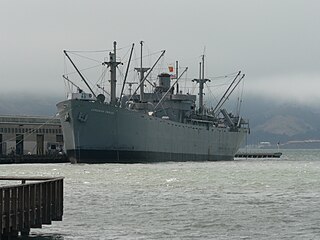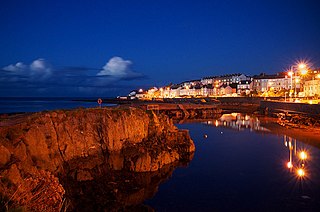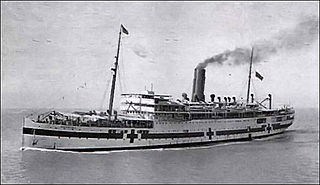
The Victory ship was a class of cargo ship produced in large numbers by North American shipyards during World War II to replace losses caused by German submarines. They were a more modern design compared to the earlier Liberty ship, were slightly larger and had more powerful steam turbine engines giving higher speed to allow participation in high speed convoys and make them more difficult targets for German U-boats. A total of 531 Victory ships were built.

SS Jeremiah O'Brien is a Liberty ship built during World War II and named after the American Revolutionary War ship captain Jeremiah O'Brien (1744–1818).

Bangor is a town in County Down, Northern Ireland. It is a seaside resort on the southern side of Belfast Lough and within the Belfast Metropolitan Area. It functions as a commuter town for the Greater Belfast area, which it is linked to by the A2 road and the Belfast–Bangor railway line. Bangor is situated 13.6 miles (22 km) east from the heart of Belfast. The population was 61,011 at the 2011 Census.

The Ann Arbor Railroad was an American railroad that operated between Toledo, Ohio, and Elberta and Frankfort, Michigan with train ferry operations across Lake Michigan. In 1967 it reported 572 million net ton-miles of revenue freight, including 107 million in "lake transfer service"; that total does not include the 39-mile subsidiary Manistique and Lake Superior Railroad.

Built for the French Line, Antilles was a near-sister to SS Flandre of 1952. Her construction was completed and her maiden voyage made in 1953. She differed from her sister mainly because she was painted white. She was placed on West Indies cruise service in the 1960s.

The four Richmond Shipyards, located in the city of Richmond, California, United States, were run by Permanente Metals and part of the Kaiser Shipyards. During World War II, Richmond built more ships than any other shipyard, turning out as many as three ships in a single day. The shipyards are part of the Rosie the Riveter/World War II Home Front National Historical Park, whose the Rosie the Riveter memorial honors the shipyard workers. Shipyard #3 is listed on the National Register of Historic Places and is a California Historical Landmark # 1032.
The Alphabet Fleet was a fleet of vessels owned and operated by the Reid Newfoundland Company as part of the provisioning of the 1898 Railway contract between the Dominion of Newfoundland and the Reid Newfoundland Company. The vessels were named after places in Scotland, the native homeland of Sir Robert Gillespie Reid, founder of the Reid Newfoundland Company.
The SS Lindenwood Victory was a Victory-class cargo ship built during World War II. The Lindenwood Victory was a type VC2-S-AP2 victory ship built by Permanente Metals Corporation, Yard 2, of Richmond, California. The Maritime Administration cargo ship was the 766th ship built. Her keel was laid on May 12, 1945. SS Lindenwood Victory was an armed cargo ship She was built in just 70 days, under the Emergency Shipbuilding program for World War II. SS Lindenwood Victory was an armed cargo ship, named for Lindenwood University in St. Charles, Missouri, one of 150 educational institutions that had Victory ships named after them. The 10,600 ton ship was constructed for the Maritime Commission.

SS Erinpura was a passenger liner built for the British-India Steam Navigation Company in 1911. She was the first British India ship built for Eastern service to be fitted with radio. She was sunk in the Mediterranean during World War II.
Brita was a cargo ship that was built in 1908 by Sunderland Shipbuilding Ltd, Sunderland as Odland for Norwegian owners. A sale in 1922 saw her renamed Odland 1. In 1928, she was sold to Sweden and renamed Brita. She was seized by Germany in 1940 at Bergen, Norway and impressed into service under the name Desiderus Siedler. In May 1945, she was seized by the Allies at Copenhagen, passed to the Ministry of War Transport (MoWT) and renamed Empire Connell. In 1947, she was sold into merchant service and renamed Ballyholme Bay. In 1951, she was sold to Hong Kong and renamed Laure Pattison. She served until 1952, when she was scrapped.
The SS Enid Victory' (MCV-712), was a type VC2-S-AP2 victory ship built by Permanente Metals Corporation, Yard 2, of Richmond, California. The Maritime Administration cargo ship was named after Enid, Oklahoma. It was the 730th ship built at the Kaiser yards. Its keel was laid on May 17, 1945. The ship was christened on June 27, 1945, with Enid Mayor Luther A. Wells in attendance. The ship was in service during World War II, Korea War, and Vietnam war.
The American Ship Building Company was the dominant shipbuilder on the Great Lakes before the Second World War. It started as Cleveland Shipbuilding in Cleveland, Ohio in 1888 and opened the yard in Lorain, Ohio in 1898. It changed its name to the American Ship Building Company in 1900, when it acquired Superior Shipbuilding, in Superior, Wisconsin; Toledo Shipbuilding, in Toledo, Ohio; and West Bay Shipbuilding, in West Bay City, Michigan. With the coming of World War I, the company also acquired Buffalo Dry Dock, in Buffalo, New York; Chicago Shipbuilding, in Chicago, Illinois; and Detroit Shipbuilding, in Wyandotte, Michigan. American Shipbuilding ranked 81st among United States corporations in the value of World War II military production contracts.
Alan Chambers is a politician from Northern Ireland. Since the 2016 election he has served as an Ulster Unionist Party (UUP) MLA for North Down.

SS Pratt Victory was a United States Victory ship which served in the Pacific Theater of Operations during the last few months of World War II. The ship's US Maritime Commission (MARCOM) designation was VC2-S-AP3, hull number 782 (V-782). SS Pratt Victory was named after Pratt Institute in New York City. It was built in 76 days at the California Shipbuilding Yard (Calship) in Los Angeles, California and was delivered on 9 May 1945.

SS Oshkosh Victory was a United States Victory ship which entered service in the Pacific Ocean shortly after the end of World War II. The ship's US Maritime Commission designation was VC2-S-AP3, hull number 808 (V-808). The ship was built at the California Shipbuilding Yard (Calship) in Los Angeles, California and was delivered on September 10, 1945. SS Oshkosh Victory was the 808th of the new 10,500-ton class ships known as Victory ships. SS Oshkosh Victory was built in 96 days, under the Emergency Shipbuilding program.

The SS St. Lawrence Victory (MCV-735) was a type VC2-S-AP2 Victory-class cargo ship built for the United States during World War II. The ship was built as part of the Emergency Shipbuilding program by Permanente Metals Corporation in Yard 2 of the Richmond Shipyards in Richmond, California.

The SS Bucknell Victory was a Victory-class cargo ship built during World War II. The Bucknell Victory was a type VC2-S-AP2 victory ship built by Permanente Metals Corporation, Yard 2, of Richmond, California. The Maritime Administration cargo ship was the 728th ship built. Her keel was laid on December 27, 1944. SS Bucknell Victory was an armed cargo ship, named for Bucknell University in Pennsylvania, one of 150 educational institutions that had Victory ships named after them. She was built in just 70 days, under the Emergency Shipbuilding program for World War II. The 10,600 ton ship was constructed for the Maritime Commission.

The SS Berea Victory (MCV-734) was a type VC2-S-AP2 Victory-class cargo ship built for the United States during World War II. The ship was built as part of the Emergency Shipbuilding program by Permanente Metals Corporation in Yard 2 of the Richmond Shipyards in Richmond, California. Launched in 3 March 1945, the Berea Victory delivered supplies for the Pacific War.







